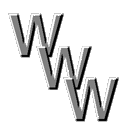
|
|
There are two divergent approaches to creating Web pages. You can
follow standards as closely as possible & have your pages look
reasonable in a range of different browsers (possibly including
text-only browsers such as Lynx), or you can aim for an attractive
visual design, although this may hide your pages from people with
browsers that can't handle the methods used to produce your design.
For the first approach you can use the canonical source of the latest
recommended HTML standard,
<URL:http://www.w3.org/pub/WWW/TR/REC-html32.html>,
but this is a rather terse technical summary; there's a similar
document at
<URL:http://www.sandia.gov/sci_compute/html_ref.html>,
a tutorial introduction (albeit still for people who already
understand some HTML) at
<URL:http://www.hut.fi/~jkorpela/HTML3.2/>,
& another reference guide with some background information at
<URL:http://www.htmlhelp.com/reference/wilbur/>.
|
|
|
One of the most prolific & outspoken advocates of the visual
design approach to Web page construction is David Seigel, who has one
set of recommendations at
<URL:http://www.dsiegel.com/tips/index.html>,
but this is just a part of a huge collection of his writings &
designs. For a slightly more restrained approach (and some very
useful links to other resources), see Joe Gillespie's site
<URL:http://ds.dial.pipex.com/pixelp/wpdesign/wpdintro.htm>,
& for more information about the best use of color on Web pages
(particularly graphs & figures) see some of Lynda Weinman's examples
on
<URL:http://www.Lynda.com/>
(that's where I obtained the color chart that sits next to my
grayscale monitor to let me know how our pages will appear to
other people).
|
|
|
These approaches don't have to be mutually exclusive. With care you
can design pages that are visually appealing in advanced browsers,
but nevertheless can display useful information to people who can't
use them (remember that students who can't afford the hardware &
connection fees to run Netscape at home may be viewing your pages
using Lynx from the U.Arizona.EDU machines). One possible solution is
to make the home page of a group of pages something fairly generic,
but then offer multiple version (e.g., with Java applets or frames)
which people can choose if they want. There's a trick we can now do
here that lets you share fragments of documents among a set of Web
pages with different display conventions (these are what are known as
server side includes). If the first page people see uses applets or
frames, it may appear completely blank, even to some quite advanced
browsers (e.g., look at a frame-based page with the latest Amaya
browser instead of Netscape). Also, don't assume that Netscape can
display all the potentially useful features of a page; in one very
important respect, the handling of what are called style sheets, the
currently released version is far behind the latest HTML standard (a pity,
because style sheets remove the need for many of the ugly tricks that
have been the resort of designers trying to produce relatively simple
font and layout changes).
|
|
|
Finally, I must stress the importance of testing your design at
various stages of construction. Don't assume because it looks
good with a particular browser on a particular machine that it will
appear that way to everyone, but check it with various different
displays & browsers. Check your HTML for errors by submitting
parts of your pages to syntax checking sites: one I have used is Web
Techs' validation service at
<URL:http://www.Webtechs.com/html-val-svc/>,
but there are several others to choose from; do a final check on the
URLs for your pages when they're complete. However this won't reveal
problems in things that fall outside the syntax of the document, such
as badly dithered color figures (then there's the spelling used in
the text of your pages, but some validators will even check this).
|

